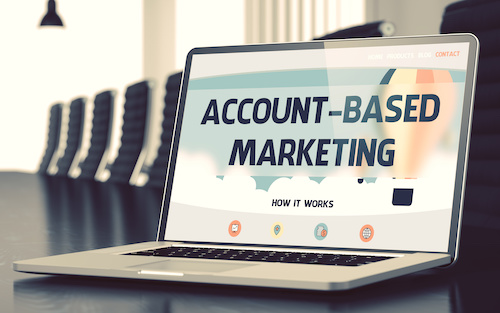Account-based marketing (ABM) is where departments work together to produce targeted, customised marketing that’s aimed at key accounts. Not the traditional marketing strategies that go out to your entire customer base.
ABM is about quality over quantity and focusing on engaging the most profitable accounts.
As you can imagine, this type of hyper-targeted marketing brings great results, with a more personalised customer experience leading to much higher quality leads.
ITSMA (Information Technology Services Marketing Association) research found that 84% of businesses that use ABM find their ROI is higher than for any other type of marketing.’
So if you’re not already engaging in ABM, now is the time to start thinking about it.
How to create an account-based marketing strategy
If ABM hasn’t been on your radar until now, you may be wondering where to even start. As with any type of marketing, planning is crucial, so creating a clearly defined strategy should be your first step:
1. Identify key accounts
As ABM focuses on the accounts that will give you the most returns, you need to start by identifying exactly which accounts they are. You need to ask, which accounts will be more inclined to spend money? And of those that are more inclined to spend, which are likely to spend the most?
This step could be the most important because if you’re putting time and effort into a targeted ABM campaign, you want to be targeting the right accounts. While input from your employees is always valuable, relying solely on human input isn’t the most successful method. AI technology such as Salesforce Einstein can drill down into your customer data and work out the most suitable accounts.
2. Engage buyers with the right messaging
Once you have the accounts identified, ABM is about tailoring your messaging to hit their sweet spots. That means identifying which channels get the most engagement from your key accounts (and it may be multiple channels) and personalising the messaging.
3. Deliver connected engagement
ABM is all about personalised, connected marketing. This means sales and marketing have to work together, not in silos. No matter which department your customers are dealing with at any time, they need to be getting the same engagement and positive, personal messaging. Every employee should be aligned around common goals for connected engagement at every customer touchpoint.
4. Grow and nurture customer relationships
ABM aims to boost revenue by developing deeper and more significant relationships with your customers. That’s something that will take time, so you must monitor and analyse your campaigns from the beginning.
So how else can you measure success? Monitor performance, optimise your campaigns, and track accounts as they move through your ABM funnel. This will help you grow the most valuable customer relationships.
How is account-based marketing used?
ABM is used to align different customer-facing departments to benefit customers. Marketing, sales, and service all work together to exceed customers’ expectations, drive long-term success, and, ultimately, increase revenue.
By identifying key accounts, collaborating to engage selected customers, and then delivering connected engagements, you can grow the most profitable customer relationships.
By aligning the different departments around one unique view of certain key accounts, ABM will help you deliver the right messages at the right time. This is done by combining customer data with marketing automation. The result? Your marketing efforts will be supercharged.
How does account-based marketing work?
It’s critical to understand the importance of marketing and what makes for successful marketing. So what’s so different about account-based marketing compared to traditional marketing? How does it work?
ABM takes that customer-centric marketing mindset one step further.
Identifying high-value accounts to target means that campaigns will be more effective and profitable.
Journeys are based on each account’s interaction history, providing dynamic web experiences that take personalisation to the next level.
Deeper insights and real-time data make it easier to deliver connected engagements across departments.
All of this helps to grow and nurture customer relationships, a practice that’s even more important in a post-pandemic business landscape. As we’ve already mentioned, your sales, marketing, and service teams don’t exist in silos. Each department needs the same complete view of each customer, which is what AI and automation bring to the table.
What is an account-based marketing programme?
Once you have your ABM strategy defined and set up, you’re ready to go ahead with your ABM programme. Remember, it should be a focused sales and marketing strategy where the relevant departments work together to provide targeted experiences for high-value accounts.
Other things to consider when you’re ready to roll out your ABM programme are:
As long as you’re using the right technology to analyse the right data, you’ll be able to personalise the messaging to perfectly connect with your key customers.
It’s not about volume. While some marketers focus on connecting with as many prospects as possible, ABM is about quality over quantity, and focusing on the right ways of engaging the most profitable accounts.
While it may seem like a lot of work initially (targeting the right accounts, focussing your messaging on their precise pain points), making the whole process more customer-centric will be so beneficial.
Why is account-based marketing important?
Personalised customer experience (CX) has always been something the most successful businesses strive for, and since COVID-19, it’s even more important. ABM offers just that, increasing both customer loyalty and marketing ROI.
It means your sales and marketing teams can focus on the most profitable accounts, and lets you engage those accounts more quickly and successfully than a generic marketing campaign ever would. Internally, it keeps different departments aligned to the same overall goals.
When there isn’t that disconnect between departments, your customers benefit from more consistency. According to the State of Marketing report, 89% of B2B marketers have an ABM program, so it’s something that is fast becoming essential.
What are some account-based marketing examples?
Creating content that’s specifically based on your chosen key accounts. Whether it’s blog posts, guides, or webinars, you’re probably already tailoring them to your general customer base. With ABM, you go even deeper into the pain points, interests, and challenges of your target account.
Sending offers and gifts that are relevant to and appreciated by your key accounts. And we don’t mean branded pens!
Engaging on social media with key accounts on a personal level.
Putting on events (virtual, for now) for your key customers. Things like focus groups and webinars aimed specifically for them.
While ABM is generally perceived as a B2B strategy, 82% of high-performing marketers believe that B2B and B2C marketing tactics are joining, so could the future of ABM include B2C?
If you want to find out more about how successful marketers are using account-based marketing, download the Sixth Edition State of Marketing report.





